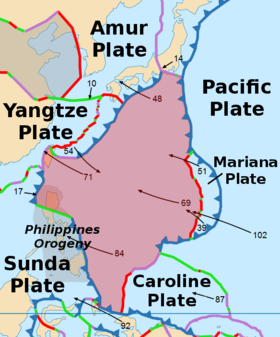This is an old revision of this page, as edited by 58.69.160.90 (talk) at 00:09, 16 September 2020. The present address (URL) is a permanent link to this revision, which may differ significantly from the current revision.
Revision as of 00:09, 16 September 2020 by 58.69.160.90 (talk)(diff) ← Previous revision | Latest revision (diff) | Newer revision → (diff) oceanic tectonic plate to the east of the Philippines| This article needs additional citations for verification. Please help improve this article by adding citations to reliable sources. Unsourced material may be challenged and removed. Find sources: "Philippine Sea plate" – news · newspapers · books · scholar · JSTOR (March 2017) (Learn how and when to remove this message) |
| Philippine Sea plate | |
|---|---|
 | |
| Type | Minor |
| Approximate area | 5,500,000 km |
| Movement | north-west |
| Speed | 48-84mm/year |
| Features | Northern Luzon, Philippine Sea, Taiwan |
| Relative to the African plate | |
The Philippine Sea Plate or the Philippine Plate is a tectonic plate comprising oceanic lithosphere that lies beneath the Philippine Sea, to the east of the Philippines. Most segments of the Philippines, including northern Luzon, are part of the Philippine Mobile Belt, which is geologically and tectonically separate from the Philippine Sea Plate.
The rim of the Pacific Ocean is the scene of much earthquake activity. Around the rim of the Pacific Ocean are many volcanoes. These volcanoes are most typically found in the regions where subduction is taking place. The ring of volcanoes around the Pacific Ocean is called the "Pacific Rim of Fire".
The Philippines have experienced frequent seismic, and volcanic activities. Around 20 earthquakes are registered daily, though most are too weak to be felt.
The Philippines is an archipelago of more than 7100 islands. Most of these islands are of volcanic origin. There are 37 volcanoes in the Philippines, of which 18 are still active volcanoes.
The most known volcanoes in the Philippines are Mount Pinatubo, Mount Mayon and the Taal volcano. They are all located on the Northern island of Luzon.
Mount Mayon is the most active volcano in the Philippines. Since 1616 there were 47 eruptions. From 1616 until 2002 at least 1300 people died and thousands of people got homeless as a result of all the eruptions.
The volcanoes of the Philippines are the most deadly and costly in the world. Fatalities have been caused by 13% of the historic eruptions, most notably at Taal and Mayon, and 22% of the eruptions caused damage. Mudflows are more common in the Philippines, compared to other regions, because of heavy rains.

See also
References
- Hall, Robert; Fuller, Michael; Ali, Jason R.; Anderson, Charles D. (1995). "The Philippine Sea Plate' Magnetism and Reconstructions" (PDF). American Geophysical Union. Retrieved October 9, 2014.
{{cite journal}}: Cite journal requires|journal=(help)
External links
- High-resolution map of Tectonic Plate Boundaries
- Map showing Seismicity of the Earth, 1900‒2012: Philippine Sea Plate and Vicinity United States Geological Survey
| Tectonic plates of Southeast Asia–New Guinea (Australian plate–Pacific plate convergence zone) | |||||||||||
|---|---|---|---|---|---|---|---|---|---|---|---|
| Large | |||||||||||
| Small |
| ||||||||||
| Faults | |||||||||||
| Trenches and troughs |
| ||||||||||
| Subsea plateaus and basins |
| ||||||||||
26°N 132°E / 26°N 132°E / 26; 132
This tectonics article is a stub. You can help Misplaced Pages by expanding it. |
